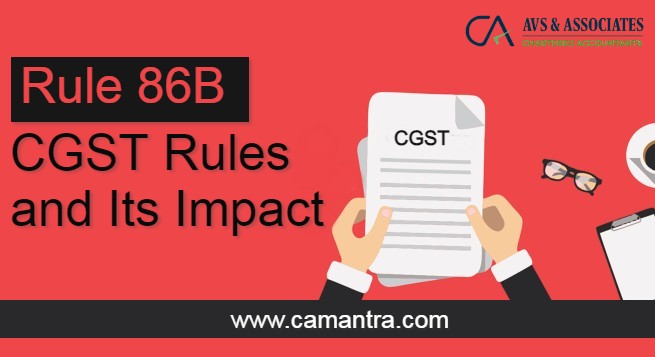The Central Board of Indirect Taxes and Customs (CBIC) has introduced new rule 86B vide notification number 94/2020 on 22nd December, 2020. Rule 86B is made effective from 01/01/ 2021.
This rule basically says that if the taxpayer’s taxable turnover exceeds above INR 50 lacs in a given month, then in that month, the taxpayer is required to pay 1% of output liability of such taxable turnover by cash ledger i.e. ITC is restricted to 99% even though taxpayer may have sufficient balance in his credit ledger.
ITC plays a very vital role in GST by avoiding cascading effect of taxation. The order of utilization of ITC for different components such as CGST, SGST and IGST has gone through a lot of changes. However, the Input tax credit available in the electronic credit ledger could always be fully utilized for discharging the output tax liability. The new Rule 86B of CGST rules has limited the use of ITC balance for paying their output tax liability.
The amendment for this rule reads as follows:
In the said rules, after rule 86A, w.e.f. the 1st January 2021, the following rule shall be inserted, namely:-
“Rule 86B of CGST Rule. Restrictions on the use of amount present in the electronic credit ledger.
Inspite of anything contained in these rules, the registered person shall not use the amount available in electronic credit ledger to discharge his/her liability towards output tax in excess of 99% of such tax liability, in cases where the value of taxable supply other than exempt supply and zero-rated supply, in a month exceeds INR 50 lacs:
Provided that the said restriction will apply in these cases–
- The said person or the proprietor or the MD or any of its two partners, whole-time Directors, Members of Managing Committee of Associations or Board of Trustees, as the case may be, have paid more than INR 1 lac as income tax under the Income-tax Act, 1961(43 of 1961) in each of the last two FY for which the time limit to file a return of income under section 139- subsection (1) of the said Act has expired; or
- The registered person has received a refund amount of more than INR 1 lac in the preceding financial year on account of unutilized input tax credit under clause (i) of the first proviso of section 54- subsection (3); or
- The registered person has received a refund amount of more than INR 1lac in the preceding financial year on account of unutilized ITC under clause (ii) of the first proviso of subsection (3) of section 54; or
- The registered person has discharged his/her liability by the electronic cash ledger towards output tax for an amount which is in excess of 1% of the total output tax liability, cumulatively applied upto the said month in the current FY; or
- The registered person is –
- Government Department; or
- PSU; or
- A local authority; or
- A statutory body:
Provided further that the Commissioner or an officer authorized by him/her in this behalf may remove the said restriction after such verifications and such safeguards as he/she may deem fit.
What is the Impact of Rule 86B on businesses & working capital?
After going through the above mentioned restrictions & exceptions introduced by Rule 86B of CGST rule, it is clear that the above rule is applicable only to the large taxpayers. There will be no effect on micro & small businesses. The motto behind the introduction of this rule is to control the issue of fake invoices to use the fake ITC to discharge liability. Further, it prevent fraudsters from showing high turnovers without having any financial credibility.
Central Board of Indirect Taxes and Customs (CBIC) has also clarified that 1% is to be calculated on the tax liability in a month & the turnover of the respective month.
Let us understand this through the help of an example:
Suppose a taxpayer X has made a sale of INR 1 crore of goods on which tax rate is 12%. In this case, he/she can discharge his liability up to 99% through ITC and must pay INR 12,000 in cash, as per this rule.
This rule has also brought genuine taxpayers under periphery making it inconvenient for them, the aim of the Government is to avoid fake invoicing and eventually curb tax evasion.

